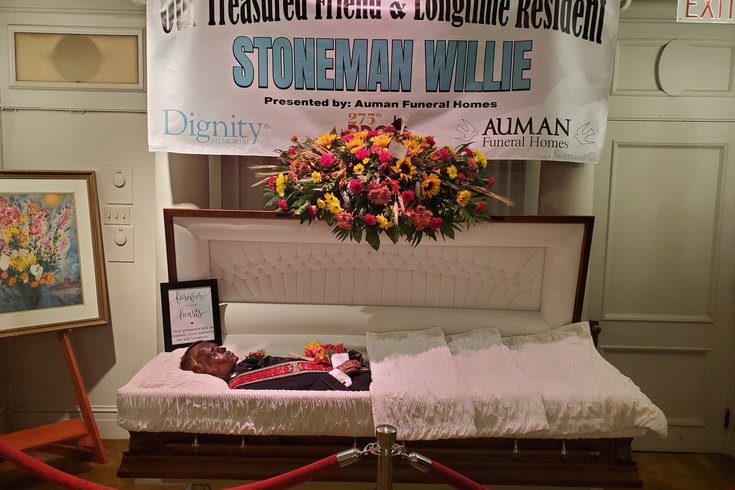
October 09, 2023
 Provided Image/Auman Funeral Home
Provided Image/Auman Funeral Home
Stoneman Willie, a mummy long displayed at Auman Funeral Home, was buried Saturday at a cemetery in Reading. His remains have been identified as James Murphy, a man who died in prison in 1895.
The mummified remains of a Pennsylvania prisoner who died in 1895 were formally identified and given a proper burial on Saturday, closing the long chapter of the body's display at a Reading funeral home.
For generations, the preserved body of "Stoneman Willie" rested in an open coffin at Auman Funeral Home. Residents and tourists often visited to pay their respects and tell grim tales about the mysterious man, whose real name was determined to be James Murphy. Some viewed him as a sideshow, recalling how his remains were "hard as marble or bronze."
The moniker Stoneman Willie referred to the leathery, petrified state of Murphy's body. He had been embalmed by Theodore Auman, the funeral home's late director, because his remains went unclaimed and no one knew for sure who he was at the time of his death. He had given a fake name in prison.
Auman was a pioneer of new embalming methods that emerged during the Civil War. The science of preserving bodies in this way was still experimental. Most local funeral directors were still putting bodies on ice to preserve them before they were buried. Auman wanted to break new ground.
"There was no written formula, really," Berks County historian George M. Meisner said in June, when plans were announced for Murphy's burial. "(Auman) experimented on his own and came up with a formula that he used for embalming Stoneman Willie."
Test samples from Murphy's mummified body revealed Auman had used high levels of arsenic, cyanide and formalin. This led to the rough, hard texture of Stoneman Willie's remains.
James Murphy, aka Stoneman Willie, is shown at Auman Funeral Home before his burial in Reading.
Records indicate Murphy had been arrested twice in the span of a week in early October 1895, once for public drunkenness and then for breaking into a boarding house. Some reports described him as a petty thief. The fake name he gave officials at Berks County Prison — either William Penn or James Penn — prevented notification of Murphy's family when he died of kidney failure that November.
Auman believed the remains likely belonged to James Murphy, but he didn't have a plan for the body. He petitioned the state to keep the remains at the funeral home, where he could study his new embalming method.
"No one claimed the body and there wasn't much prospect of anyone coming to claim the body," Meisner said. "(Auman) wanted the body to remain as long as possible to see how successful his procedure was."
Auman died in 1933, passing the funeral home to his surviving family members. Stoneman Willie's legend continued to grow in Reading. In the 1950s, state officials agreed to an open-ended arrangement with the funeral home to keep the body there. The efforts to confirm Murphy's identity continued in the ensuing decades.
Kyle Blankenbiller, the current director at Auman's Funeral Home, explained in June that Murphy was a New York resident and Irish immigrant. He had a reputation for drinking and was likely in Reading in October 1895 for a state convention of firefighters.
Although a hair analysis and other DNA methods had been used to try to identify Murphy in the last 15 years, there was no database available from the time of his death to use for comparison. Another problem with confirming his identity was that Auman had embalmed another man, Michael Pohouski, using a similar method around the same time.
Cemetery records showed that Pohouski had been buried. Blankenbiller was finally able to identify a relative of Murphy's who was living in Manhattan in the mid-1890s, giving him the confidence he needed to move forward with the identification and burial. It originally had been planned in 2020, but was delayed by the COVID-19 pandemic.
"There's a lot of lore around him that is still very well unknown," Blankenbiller said.
Murphy was buried Saturday at the Forest Hills Memorial Park cemetery in Reading. His granite tombstone is inscribed with both of his names, James Murphy and Stoneman Willie.
In the week before the burial, Auman Funeral Home held public visitation hours for people to get a last look at the mummy. He was dressed in a tuxedo that would have been customary for men at the time of his death.
"We don't like to see him leave," Blankenbiller said in June. "He's a local legend and very endearing to all of us here. He's a big identity of our funeral home."
Murphy's burial, which coincided with Reading's 275th anniversary parade, had a few hitches, The New York Times reported. An elevator at the funeral home broke down when it was time to move Murphy's coffin. Then the hearse intended for the transport of the coffin overheated, requiring Murphy's remains to be pulled by a pair of motorcycles. One of those broke down, further stalling the event until a backup hearse arrived. Murphy eventually reached his final resting place.
The funeral home plans to install information about Murphy's story at the grave site and also will develop commemorative literature to help celebrate his legacy.
 Provided Image/Aumen Funeral Home
Provided Image/Aumen Funeral Home